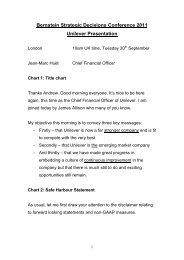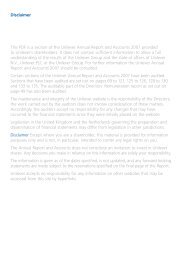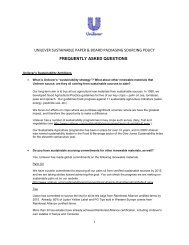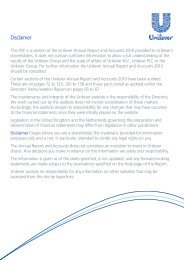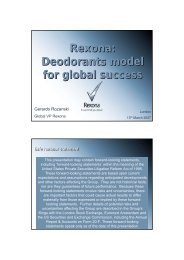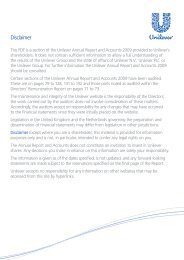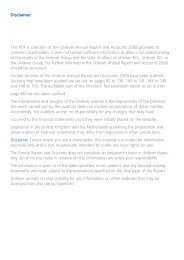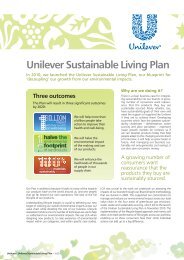Report & accounts 2002 in full - Unilever
Report & accounts 2002 in full - Unilever
Report & accounts 2002 in full - Unilever
Create successful ePaper yourself
Turn your PDF publications into a flip-book with our unique Google optimized e-Paper software.
38 F<strong>in</strong>ancial review<br />
equivalent of €418 million of term f<strong>in</strong>anc<strong>in</strong>g <strong>in</strong> the Thai<br />
capital market, all of which carried a <strong>Unilever</strong> NV guarantee<br />
exclud<strong>in</strong>g political risk, through a comb<strong>in</strong>ation of bank loans<br />
and the issuance of a debenture with a 5-year maturity.<br />
Dur<strong>in</strong>g <strong>2002</strong>, net debt decreased to €16 966 million<br />
(2001: €23 199 million). This was due to strong operat<strong>in</strong>g<br />
cash flow, the proceeds of bus<strong>in</strong>ess disposals and the<br />
favourable effect of currency movements.<br />
Borrow<strong>in</strong>gs at the end of <strong>2002</strong> totalled €20 444 million<br />
(2001: €25 500 million). Tak<strong>in</strong>g <strong>in</strong>to account the various<br />
cross currency swaps and other derivatives, 78% of<br />
<strong>Unilever</strong>’s borrow<strong>in</strong>gs were <strong>in</strong> US dollars, 1% <strong>in</strong> euros<br />
and 7% <strong>in</strong> sterl<strong>in</strong>g with the rema<strong>in</strong>der spread over a<br />
large number of other currencies.<br />
Long-term borrow<strong>in</strong>gs decreased by €3 288 million<br />
to €10 933 million at the end of <strong>2002</strong>. At the end of<br />
<strong>2002</strong> short-term borrow<strong>in</strong>gs were €9 511 million (2001:<br />
€11 279 million), <strong>in</strong>clud<strong>in</strong>g €4 854 million of long-term<br />
debt com<strong>in</strong>g to with<strong>in</strong> a year of maturity at the year-end.<br />
At the end of <strong>2002</strong>, 68% of the long-term debt is repayable<br />
with<strong>in</strong> five years (2001: 77%).<br />
<strong>Unilever</strong>’s contractual obligations at the end of <strong>2002</strong> <strong>in</strong>clude<br />
capital expenditure commitments, borrow<strong>in</strong>gs, operat<strong>in</strong>g<br />
lease commitments and other commitments. Details are set<br />
out <strong>in</strong> the follow<strong>in</strong>g notes to the <strong>accounts</strong>: note 10 on page<br />
81, note 14 on page 83, and note 24 on page 99. Details<br />
on derivatives are given <strong>in</strong> note 15 on pages 85 and 86.<br />
Cash and current <strong>in</strong>vestments at the end of <strong>2002</strong> totalled<br />
€3 478 million (2001: €2 301 million); these funds were<br />
held <strong>in</strong> euros (34%), sterl<strong>in</strong>g (4%), US dollars (14%), and<br />
other currencies (48%). The funds are ma<strong>in</strong>ly to support<br />
day-to-day needs and are predom<strong>in</strong>antly <strong>in</strong>vested <strong>in</strong> shortterm<br />
bank deposits and high-grade marketable securities.<br />
Treasury and hedg<strong>in</strong>g policies<br />
<strong>Unilever</strong> Treasury’s strategic purpose is to provide f<strong>in</strong>ancial<br />
flexibility <strong>in</strong> support of <strong>Unilever</strong>’s Path to Growth strategy<br />
with<strong>in</strong> the context of the f<strong>in</strong>ancial strategy set out <strong>in</strong> the<br />
‘F<strong>in</strong>ance and liquidity’ section above. <strong>Unilever</strong> Treasury’s role<br />
is to ensure that appropriate f<strong>in</strong>anc<strong>in</strong>g is always available for<br />
all value-creat<strong>in</strong>g <strong>in</strong>vestments. Additionally, Treasury delivers<br />
f<strong>in</strong>ancial services to allow operat<strong>in</strong>g companies to manage<br />
their f<strong>in</strong>ancial transactions and exposures <strong>in</strong> an efficient,<br />
timely and low cost manner.<br />
<strong>Unilever</strong> Treasury operates as a service centre and is<br />
governed by policies and plans agreed by the Executive<br />
Committee of the Board. In addition to policies, guidel<strong>in</strong>es<br />
and exposure limits, a system of authorities and extensive<br />
<strong>in</strong>dependent report<strong>in</strong>g covers all major areas of activity.<br />
Performance is monitored closely. Reviews are undertaken<br />
by the corporate <strong>in</strong>ternal audit function.<br />
<strong>Unilever</strong> Annual <strong>Report</strong> & Accounts and Form 20-F <strong>2002</strong><br />
The key f<strong>in</strong>ancial <strong>in</strong>struments used by <strong>Unilever</strong> are shortand<br />
long-term borrow<strong>in</strong>gs, cash and other fixed and<br />
current <strong>in</strong>vestments and certa<strong>in</strong> straightforward derivative<br />
<strong>in</strong>struments, pr<strong>in</strong>cipally compris<strong>in</strong>g <strong>in</strong>terest rate swaps and<br />
foreign exchange contracts. The account<strong>in</strong>g for derivative<br />
<strong>in</strong>struments is discussed <strong>in</strong> Account<strong>in</strong>g policies on page 68.<br />
The use of leveraged <strong>in</strong>struments is not permitted.<br />
<strong>Unilever</strong> Treasury manages a variety of market risks,<br />
<strong>in</strong>clud<strong>in</strong>g the effects of changes <strong>in</strong> foreign exchange rates,<br />
<strong>in</strong>terest rates and credit spreads. Other risks managed<br />
<strong>in</strong>clude liquidity, country and counterparty risks.<br />
<strong>Unilever</strong> has an <strong>in</strong>terest rate management policy aimed at<br />
optimis<strong>in</strong>g net <strong>in</strong>terest cost and reduc<strong>in</strong>g volatility. This is<br />
achieved by modify<strong>in</strong>g the <strong>in</strong>terest rate exposure of debt<br />
and cash positions through the use of <strong>in</strong>terest rate swaps.<br />
At the <strong>2002</strong> year-end the application of this policy resulted<br />
<strong>in</strong> approximately 80% of our projected net debt for 2003<br />
and 47% for 2004 be<strong>in</strong>g fixed.<br />
<strong>Unilever</strong>’s foreign exchange policy requires that operat<strong>in</strong>g<br />
companies hedge trad<strong>in</strong>g and f<strong>in</strong>ancial foreign exchange<br />
exposures. This is achieved primarily through the use of<br />
forward foreign exchange contracts. Some flexibility is<br />
permitted with<strong>in</strong> overall exposure limits. At year-end there<br />
was no material exposure from companies hold<strong>in</strong>g assets<br />
and liabilities other than <strong>in</strong> their functional currency.<br />
<strong>Unilever</strong> aims to hedge its net <strong>in</strong>vestment <strong>in</strong> operat<strong>in</strong>g<br />
companies through borrow<strong>in</strong>gs <strong>in</strong> the same currency, except<br />
where <strong>in</strong>hibited by local regulations, lack of local liquidity or<br />
local market conditions. An exception may also be made<br />
where the economic value of the net assets locally is<br />
considered to exceed their book value substantially. The<br />
bus<strong>in</strong>ess <strong>in</strong> the US is one such example where the economic<br />
value of the assets is considerably <strong>in</strong> excess of book value<br />
and accord<strong>in</strong>gly we have higher US dollar debt. From time<br />
to time, currency revaluations will trigger exchange<br />
translation movements <strong>in</strong> our balance sheet as a result<br />
of these exceptions.<br />
In <strong>2002</strong>, we suffered significant retranslation differences as<br />
aresult of the devaluations <strong>in</strong> Brazil (€1 106 million) and<br />
Argent<strong>in</strong>a (€502 million), partly offset by the effect of the<br />
weaken<strong>in</strong>g of the US dollar. The above figures reflect the<br />
effect exchange rate movements have on the book values<br />
of assets and liabilities but do not take <strong>in</strong>to account the<br />
underly<strong>in</strong>g value of our assets or future earn<strong>in</strong>gs potential<br />
<strong>in</strong> the countries <strong>in</strong>volved.<br />
Our policies and strategies for the management of liquidity<br />
risk are discussed <strong>in</strong> more detail on pages 37 and above.<br />
Counterparty exposures are m<strong>in</strong>imised by restrict<strong>in</strong>g deal<strong>in</strong>g<br />
counterparties to a limited number of f<strong>in</strong>ancial <strong>in</strong>stitutions<br />
that have secure credit rat<strong>in</strong>gs, by work<strong>in</strong>g with<strong>in</strong> agreed<br />
counterparty limits and by sett<strong>in</strong>g limits on the maturity of<br />
exposures. Counterparty credit rat<strong>in</strong>gs are closely monitored<br />
and concentration of credit risk with any s<strong>in</strong>gle counterparty









